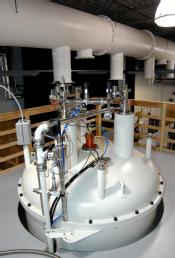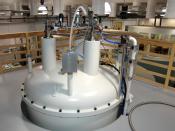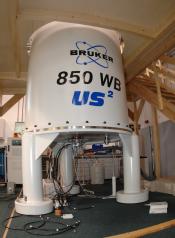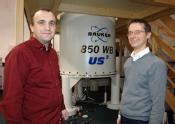Advanced drugs in sights as UK’s most powerful Nuclear Magnetic Resonance (NMR) device powers away at University of Warwick
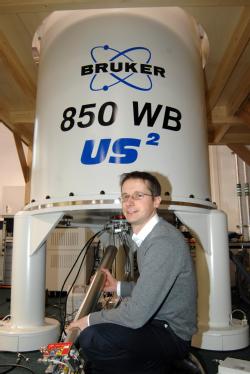 UK researchers will gain new insights into vital high tech engineering materials and novel pharmaceuticals thanks to the creation of the UK’s most powerful NMR device for solids now sited in a national research facility in the University of Warwick’s Centre for Magnetic Resonance.
UK researchers will gain new insights into vital high tech engineering materials and novel pharmaceuticals thanks to the creation of the UK’s most powerful NMR device for solids now sited in a national research facility in the University of Warwick’s Centre for Magnetic Resonance.
The new £3.7 million “UK 850 MHz Solid-State NMR Facility” was launched in the University of Warwick’s Millburn house on Thursday October 28th at 5pm.
It is a national facility open to a large range of researchers across the UK and has been made possible by the award of a £3.7M grant from the Engineering and Physical Sciences Research Council (EPSRC) and the Biotechnology and Biological Sciences Research Council (BBSRC). It also received funding through the Birmingham Science City initiative supported by Advantage West Midlands (AWM) and the European Regional Development Fund (ERDF).
The new facility was formally launched by David Delpy, the Chief Executive of EPSRC at a special event attended by researchers from all the main facility partners (the Universities of Warwick, Cambridge, Durham, Nottingham, Glasgow and St Andrews). In his speech David Delpy indicated that EPSRC wanted to see more shared use of significant science reserach facilites funded by EPSRC and he described the 850 MHz Solid-State NMR facility as "an exemplar" of such a resource.
David Delpy said:
“The EPSRC are pleased to have supported the UK’s internationally leading research for over 15 years. NMR spectroscopy is a vital analytical tool across science. It is a powerful technique that can provide detailed information on the topology, dynamics and three-dimensional structure of molecules in solution and the solid state.”
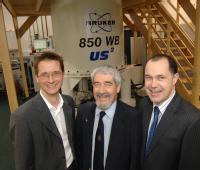
 Professor Mark Smith Deputy Vice-Chancellor of the University of Warwick said:
Professor Mark Smith Deputy Vice-Chancellor of the University of Warwick said:
“This facility provides a significant leap in the capability available to the UK’s NMR spectroscopy researchers that allows us to compete with the very best in the world. This was possible through the coordinated efforts of a wide range of researchers and funders and is a model of such a partnership for developing such facilities for the UK in the future. It is certain to provide us with new insights into everything from potential new pharmaceuticals to innovate materials for the next generation of catalytic convertors”
More information on the facility can be found at:
http://www2.warwick.ac.uk/fac/sci/physics/research/condensedmatt/nmr/850
Notes for editors
About EPSRC
The Engineering and Physical Sciences research Council (EPSRC) is the UK’s main agency for funding research in engineering and physical sciences. EPSRC invests around £850m a year in research and postgraduate training, to help the nation handle the next generation of technological change.
The areas covered range from information technology to structural engineering, and mathematics to materials science. This research forms the basis for future economic development in the UK and improvements for everyone’s health, lifestyle and culture. EPSRC also actively promotes public awareness of science and engineering. EPSRC works alongside other Research Councils with responsibility for other areas of research. The Research Councils work collectively on issues of common concern via research Councils UK.
About BBSRC
The Biotechnology and Biological Sciences Research Council (BBSRC) is the UK funding agency for research in the life sciences. Sponsored by Government, BBSRC annually invests around £470 million in a wide range of research that makes a significant contribution to the quality of life for UK citizens and supports a number of important industrial stakeholders including the agriculture, food, chemical, healthcare and pharmaceutical sectors. BBSRC carries out its mission by funding internationally competitive research, providing training in the biosciences, fostering opportunities for knowledge transfer and innovation and promoting interaction with the public and other stakeholders on issues of scientific interest in universities, centres and institutes.
The Babraham Institute, Institute for Animal Health, Institute of Food Research, John Innes Centre and Rothamsted Research are Institutes of BBSRC. The Institutes conduct long-term, mission-oriented research using specialist facilities. They have strong interactions with industry, Government departments and other end-users of their research.
the NMR Facility at Warwick
| A powerful 20 Tesla 850MHz Solid-State NMR facility is based at the University of Warwick. The facility allows researchers to gain a detailed understanding of the structure and motion of molecules which will help in the creation of new materials for hydrogen storage, new drug development and can even provide insights into diseases such as Alzheimer's. |
|
For further information please contact:
Peter Dunn, email: p.j.dunn@warwick.ac.uk
Head of Communications, Communications Office, University House,
University of Warwick, Coventry, CV4 8UW, United Kingdom
Tel: (+44) (0)24 7652 3708
Mobile: (+44) (0)77 6765 5860
Victoria McGuire, email: victoria.mcguire@epsrc.ac.uk
EPSRC Press Office
Tel: 01793 444267
PR 140m 28th October 2010


